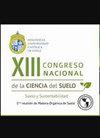Sorption-Desorption Processes of Metals and Metalloids in Soil Environments
Revista De La Ciencia Del Suelo Y Nutricion Vegetal
Pub Date : 2008-01-01
DOI:10.4067/S0718-27912008000400015
引用次数: 9
Abstract
Trace elements may be present in solution with positive or negative charges and in different redox state. They occur predominantly in cationic form (Pb, Cu, Zn, Ni, Cd, Hg, Cr(III), Co) but some trace elements are present in anionic form (As, Se, Cr(VI), Mo and B). In soil environments, sorption/desorption reactions on/from inorganic and organic sorbents control the concentration of metals and metalloids in solution and affect their bioavailability, leaching and toxicity. Sorption-desorption processes of elements in cationic form differ greatly from those in anionic form. These reactions are affected by many factors, such as pH, nature of the sorbents, presence and concentration of organic and inorganic ligands, including humic and fulvic acids, root exudates and nutrients. Furthermore, redox reactions, both biotic and abiotic, are of great importance in controlling the oxidation state and thus, the mobility, the phytoavailability and the toxicity of many elements, such as Cr, Se, Co, Pb, As, Ni and Cu (Kabata-Pendias, 2001; Huang and Germida, 2002; Violante et al., 2002; Sparks, 2003; Huang and Gobran, 2005; Violante et al., 2007). The aim of this presentation is to provide information on the factors which affect the mobility of trace elements. Special attention is devoted to the influence of inorganic and organic ligands, including nutrients and root exudates, on the sorption/desorption processes of trace elements in cationic and anionic forms on/from soil components, soils and selected synthetic minerals (double layered hydroxides, the so called “anionic clays”). The soil components responsible for trace element sorption include, soil humic substances, phyllosilicates, carbonates and variable charge minerals (constituents such as Fe, Al, Mn and Ti oxides, short-range ordered aluminosilicates as well as phyllosilicates coated by OH-Al or OH-Fe species whose charge varies with the pH of the soil solution). Recently, evidence on the sorption of heavy metals on microorganisms have been reported (Jackson, 1998). Soil components differ greatly in their sorption capacities, their cation and anion exchange capacities, and the binding energies of their sorption sites. Trace element sorption kinetics depend on the type of surface and trace element, but generally are rapid. Half times for bivalent cations, such as Pb, Zn, Cu and Cd, sorption on peat range from 5 to 15 seconds. Except for some noncrystalline minerals that have very high specific surface charge density with highly reactive sites, humic substances appear to have the greatest capacity for sorption of trace elements in cationic form. A body of evidence has demonstrated that humic matter and metal oxides are much more effective scavengers of trace elements in cationic form, than even the most efficient sorbent among phyllosilicates, indicating that specific sorption and other complexation processes are the dominant binding mechanisms (Jackson, 1998; Huang and Germida, 2002; Spark, 2003). Complexation reactions have the following effects: i) metal ions are prevented from being precipitated; ii) complexing agents can act as carriers for trace elements in soil solution; iii) their toxicity is often reduced by complexation.金属及类金属在土壤环境中的吸附-解吸过程
微量元素可以带正电荷或负电荷,以不同的氧化还原状态存在于溶液中。它们主要以阳离子形式存在(Pb, Cu, Zn, Ni, Cd, Hg, Cr(III), Co),但也有一些微量元素以阴离子形式存在(As, Se, Cr(VI), Mo和B)。在土壤环境中,无机和有机吸附剂的吸附/解吸反应控制了溶液中金属和类金属的浓度,并影响其生物有效性,淋溶性和毒性。阳离子形式元素的吸附-解吸过程与阴离子形式元素的吸附-解吸过程有很大不同。这些反应受到许多因素的影响,如pH值、吸附剂的性质、有机和无机配体(包括腐植酸和黄腐酸)的存在和浓度、根渗出物和营养物质。此外,生物和非生物氧化还原反应在控制氧化状态以及许多元素(如Cr、Se、Co、Pb、as、Ni和Cu)的迁移性、植物可利用性和毒性方面具有重要意义(Kabata-Pendias, 2001;Huang and Germida, 2002;Violante et al., 2002;火花,2003;Huang and Gobran, 2005;Violante et al., 2007)。本报告的目的是提供有关影响微量元素迁移的因素的信息。特别注意无机和有机配体,包括营养物和根渗出物,对阳离子和阴离子形式的微量元素在土壤成分、土壤和选定的合成矿物(双层氢氧化物,即所谓的"阴离子粘土")上/从土壤中吸附/解吸过程的影响。负责微量元素吸附的土壤成分包括土壤腐殖质、层状硅酸盐、碳酸盐和可变电荷矿物(如Fe、Al、Mn和Ti氧化物、短程有序铝硅酸盐以及被OH-Al或OH-Fe包覆的层状硅酸盐,其电荷随土壤溶液的pH值而变化)。最近,有证据表明微生物对重金属的吸附作用(Jackson, 1998)。土壤组分的吸附能力、阳离子和阴离子交换能力以及吸附位点的结合能差异很大。微量元素的吸附动力学取决于表面和微量元素的类型,但通常是快速的。对于二价阳离子,如Pb、Zn、Cu和Cd,在泥炭上的吸附时间为5至15秒。除了一些非晶矿物具有非常高的比表面电荷密度和高活性位点外,腐殖质物质对阳离子形式的微量元素的吸附能力最大。大量证据表明,腐殖质和金属氧化物是阳离子形式微量元素的更有效清除剂,甚至比层状硅酸盐中最有效的吸附剂还要有效,这表明特定的吸附和其他络合过程是主要的结合机制(Jackson, 1998;Huang and Germida, 2002;火花,2003)。络合反应有以下作用:1)防止金属离子析出;Ii)络合剂可作为土壤溶液中微量元素的载体;Iii)它们的毒性常因络合作用而降低。
本文章由计算机程序翻译,如有差异,请以英文原文为准。
求助全文
约1分钟内获得全文
求助全文

 求助内容:
求助内容: 应助结果提醒方式:
应助结果提醒方式:


